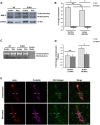Transient mechanical strain promotes the maturation of invadopodia and enhances cancer cell invasion in vitro
- PMID: 28446539
- PMCID: PMC6865334
- DOI: 10.1242/jcs.199760
Transient mechanical strain promotes the maturation of invadopodia and enhances cancer cell invasion in vitro
Abstract
Cancer cell invasion is influenced by various biomechanical forces found within the microenvironment. We have previously found that invasion is enhanced in fibrosarcoma cells when transient mechanical stimulation is applied within an in vitro mechano-invasion assay. This enhancement of invasion is dependent on cofilin (CFL1), a known regulator of invadopodia maturation. Invadopodia are actin-rich structures present in invasive cancer cells that are enzymatically active and degrade the surrounding extracellular matrix to facilitate invasion. In this study, we examine changes in gene expression in response to tugging on matrix fibers. Interestingly, we find that integrin β3 expression is downregulated and leads to an increase in cofilin activity, as evidenced by a reduction in its Ser3 phosphorylation levels. As a result, invadopodia lengthen and have increased enzymatic activity, indicating that transient mechanical stimulation promotes the maturation of invadopodia leading to increased levels of cell invasion. Our results are unique in defining an invasive mechanism specific to the invasive process of cancer cells that is triggered by tugging forces in the microenvironment, as opposed to rigidity, compression or stretch forces.
Keywords: Cancer; Cell invasion; Cell mechanics; Cofilin; Invadopodia.
© 2017. Published by The Company of Biologists Ltd.
Conflict of interest statement
Competing interestsThe authors declare no competing or financial interests.
Figures








Similar articles
-
The Role of PAK1 in the Maturation of Invadopodia During Transient Mechanical Stimulation.Front Cell Dev Biol. 2019 Nov 6;7:269. doi: 10.3389/fcell.2019.00269. eCollection 2019. Front Cell Dev Biol. 2019. PMID: 31781560 Free PMC article.
-
Matrix rigidity differentially regulates invadopodia activity through ROCK1 and ROCK2.Biomaterials. 2016 Apr;84:119-129. doi: 10.1016/j.biomaterials.2016.01.028. Epub 2016 Jan 15. Biomaterials. 2016. PMID: 26826790 Free PMC article.
-
β1 integrin regulates Arg to promote invadopodial maturation and matrix degradation.Mol Biol Cell. 2013 Jun;24(11):1661-75, S1-11. doi: 10.1091/mbc.E12-12-0908. Epub 2013 Apr 3. Mol Biol Cell. 2013. PMID: 23552693 Free PMC article.
-
The matrix environmental and cell mechanical properties regulate cell migration and contribute to the invasive phenotype of cancer cells.Rep Prog Phys. 2019 Jun;82(6):064602. doi: 10.1088/1361-6633/ab1628. Epub 2019 Apr 4. Rep Prog Phys. 2019. PMID: 30947151 Review.
-
Regulation of invadopodia by mechanical signaling.Exp Cell Res. 2016 Apr 10;343(1):89-95. doi: 10.1016/j.yexcr.2015.10.038. Epub 2015 Nov 4. Exp Cell Res. 2016. PMID: 26546985 Free PMC article. Review.
Cited by
-
Integrins, CAFs and Mechanical Forces in the Progression of Cancer.Cancers (Basel). 2019 May 24;11(5):721. doi: 10.3390/cancers11050721. Cancers (Basel). 2019. PMID: 31137693 Free PMC article. Review.
-
The destructive spontaneous ingression of tunable silica nanosheets through cancer cell membranes.Chem Sci. 2019 May 8;10(24):6184-6192. doi: 10.1039/c9sc00076c. eCollection 2019 Jun 28. Chem Sci. 2019. PMID: 31360425 Free PMC article.
-
Fascin limits Myosin activity within Drosophila border cells to control substrate stiffness and promote migration.Elife. 2021 Oct 26;10:e69836. doi: 10.7554/eLife.69836. Elife. 2021. PMID: 34698017 Free PMC article.
-
Establishment of a Basement Membrane-Related Prognosis Model and Characterization of Tumor Microenvironment Infiltration in Acute Myeloid Leukemia.J Cancer. 2025 Jan 13;16(4):1228-1242. doi: 10.7150/jca.108041. eCollection 2025. J Cancer. 2025. PMID: 39895788 Free PMC article.
-
Integrins: Moonlighting Proteins in Invadosome Formation.Cancers (Basel). 2019 May 2;11(5):615. doi: 10.3390/cancers11050615. Cancers (Basel). 2019. PMID: 31052560 Free PMC article. Review.
References
-
- Antelmi E., Cardone R. A., Greco M. R., Rubino R., Di Sole F., Martino N. A., Casavola V., Carcangiu M. L., Moro L. and Reshkin S. J. (2013). β1 integrin binding phosphorylates ezrin at T567 to activate a lipid raft signalsome driving invadopodia activity and invasion. PLoS ONE 8, e75113 10.1371/journal.pone.0075113 - DOI - PMC - PubMed
-
- Artym V. V., Zhang Y., Seillier-Moiseiwitsch F., Yamada K. M. and Mueller S. C. (2006). Dynamic interactions of cortactin and membrane type 1 matrix metalloproteinase at invadopodia: defining the stages of invadopodia formation and function. Cancer Res. 66, 3034-3043. 10.1158/0008-5472.CAN-05-2177 - DOI - PubMed
MeSH terms
Substances
Grants and funding
LinkOut - more resources
Full Text Sources
Other Literature Sources
Molecular Biology Databases
Research Materials
Miscellaneous

